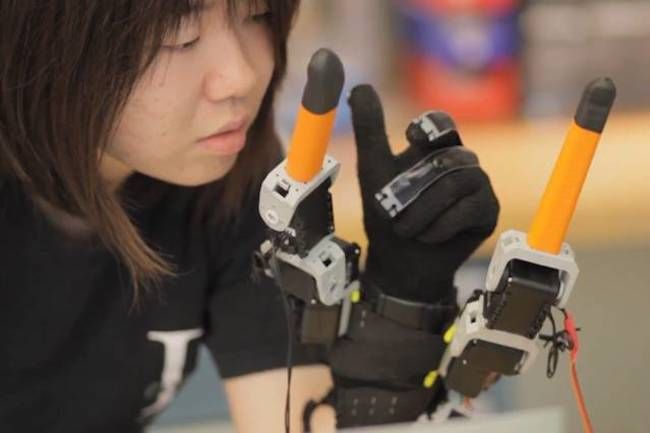Bionic Fingers Could Help Humans Get a Grip

A new robotic device could make simple, everyday tasks — such as peeling a banana or unscrewing the cap from a water bottle — even easier.
Developed by researchers at the Massachusetts Institute of Technology, the "supernumerary robotic fingers" device is a wrist-mounted robot equipped with two long digits. A specially designed algorithm controls the digits, enabling them to move in sync with the wearer's real fingers.
"This is a completely intuitive and natural way to move your robotic fingers," Harry Asada, a professor of engineering at MIT, said in a statement. "You do not need to command the robot but simply move your fingers naturally. Then the robotic fingers react and assist your fingers." [The 6 Strangest Robots Ever Created]
The algorithm that controls the bionic digits is based on two general patterns of motion, the same patterns that people use when grasping an object. The first pattern involves bringing the fingers together, and the second involves twisting the fingers inward.
Using just these simple gestures, the robotic fingers let users do things with one hand that would normally require two hands. For example, the bionic fingers can hold a jar while your real fingers unscrew the top.
Though it has mastered these simple motions, there's still a lot that this handy robot can't do. However, the researchers said they're working on ways to improve the prototype device.
For instance, the researchers are examining how the wrist-mounted device can adapt to handling heavier objects, and how the fingers should be positioned to grip things that are slippery.
Sign up for the Live Science daily newsletter now
Get the world’s most fascinating discoveries delivered straight to your inbox.
The researchers are also hoping to develop a way for the robot to grasp things according to a user's specific preferences.
Certain gestures, such as grabbing an apple, vary from person to person. A robotic device that learns its user's preferences for handling objects — something the researchers call machine learning— could be very useful, said Faye Wu, a graduate student of mechanical engineering at MIT, who worked on the project with Asada. She said the robot could learn in a similar way to Siri, the voice-controlled personal assistant on Apple's iPhones.
"After you've been using [Siri] for a while, it gets used to your pronunciation so it can tune to your particular accent," Wu said. "Long-term, our technology can be similar, where the robot can adjust and adapt to you."
Asada also has high hopes for future applications of the robotic fingers. One day, the device could be used by people with limited dexterity, he said. But before the robot becomes really useful, Asada said it will likely require a redesign.
"This is a prototype, but we can shrink it down to one-third its size, and make it foldable," Asada said. “We could make this into a watch or a bracelet where the fingers pop up, and when the job is done, they come back into the watch. Wearable robots are a way to bring the robot closer to our daily life.”
Follow Elizabeth Palermo on Twitter @techEpalermo, Facebook or Google+. Follow Live Science @livescience. We're also on Facebook & Google+. Original article on Live Science.

Elizabeth is a former Live Science associate editor and current director of audience development at the Chamber of Commerce. She graduated with a bachelor of arts degree from George Washington University. Elizabeth has traveled throughout the Americas, studying political systems and indigenous cultures and teaching English to students of all ages.










